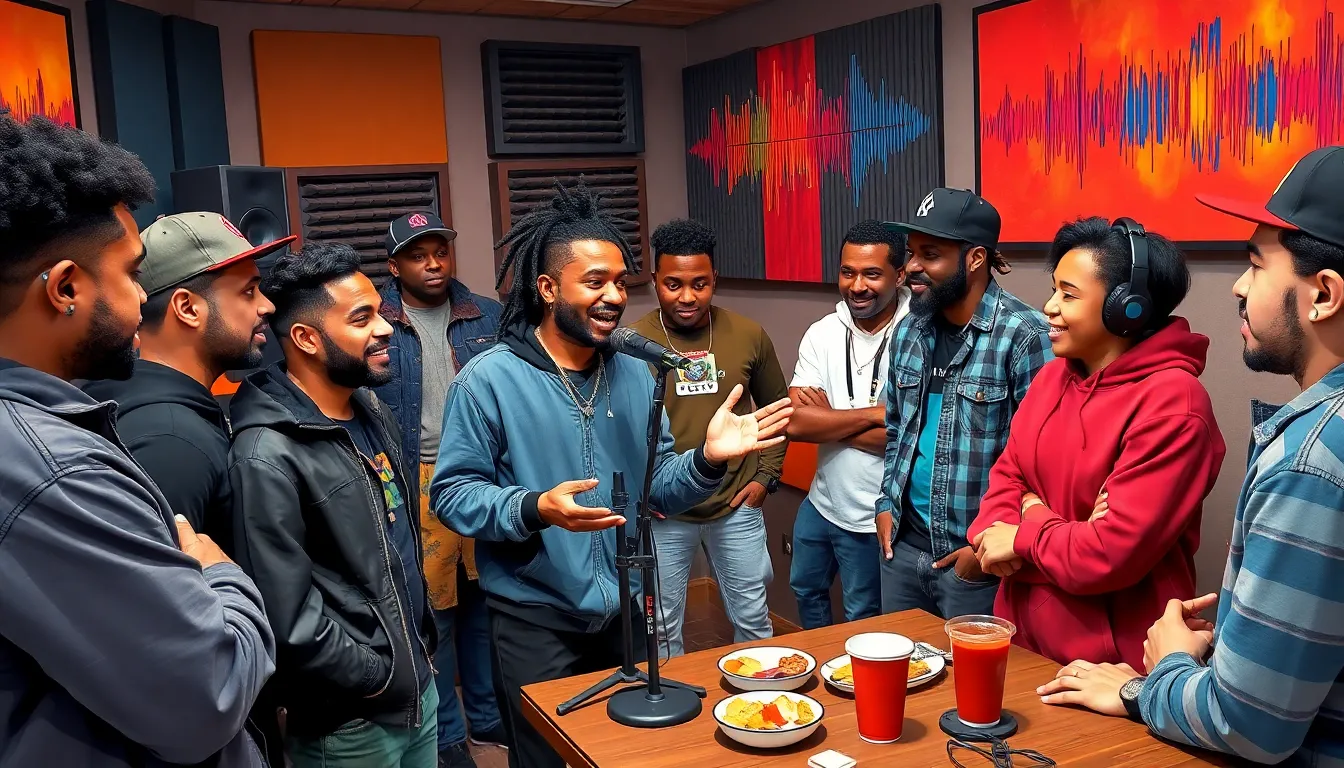Table of Contents
ToggleRap studio sessions are where the magic happens, turning raw emotions into lyrical gold. Picture this: a room filled with beats, rhymes, and the unmistakable energy of creativity. It’s not just about laying down tracks; it’s a wild ride of brainstorming, laughter, and occasional snack breaks that fuel the fire of inspiration.
Overview of Rap Studio Sessions
Rap studio sessions create an electrifying environment where creativity flourishes. Artists collaborate, turning their thoughts and feelings into powerful lyrics. The chemistry among participants often leads to spontaneous brainstorming sessions, resulting in unique expressions of artistry.
Producers play a crucial role in shaping the sound. They provide beats that complement the lyrical themes. Rappers contribute their perspectives, offering stories that resonate with listeners. This dialogue fosters a rich exchange of ideas, fueling the creative process.
Laughter and camaraderie fill the air, enhancing the overall experience. During breaks, musicians often share snacks and anecdotes, further bonding them as a team. These interactions can spark inspiration, influencing the direction of the music being created.
Flexible methodologies characterize these sessions. Some artists prefer structured approaches, while others embrace spontaneity. Both styles can yield exceptional results, demonstrating that there’s no single path to creativity in the studio.
Acoustic treatment in studio spaces also shapes the outcome. Proper soundproofing and equipment help artists focus on their performances. Quality microphones and mixing boards ensure that every nuance in their delivery gets captured effectively.
Ultimately, the energy during rap studio sessions transforms raw ideas into polished tracks. Each session contributes to the broader music landscape, impacting listeners far beyond the studio walls. The shared experience within these creative spaces often cultivates a sense of community among artists.
Key Elements of a Successful Session


Successful rap studio sessions hinge on key elements that enhance creativity and productivity. These elements help in transforming concepts into compelling songs.
Songwriting Process
The songwriting process often starts with concepts. Artists craft melodies and lyrics that express genuine emotions. Unique perspectives surface through brainstorming sessions, where artists exchange ideas and refine their thoughts. They frequently break down songs into verses and hooks, ensuring each part resonates. Capturing authentic experiences results in relatable verses that connect with listeners. Flexibility within this process allows room for improvisation. Experimenting with different song structures can lead to surprising and impactful outcomes. Clarity in communication among collaborators ultimately shapes the direction of the song.
Collaborating with Producers
Collaboration with producers plays an essential role in shaping a track’s sound. Producers provide beats that complement lyrics while enhancing the overall vibe. Active discussions about the song’s mood foster creative synergy between artists and producers. Producers’ expertise in sound engineering ensures high-quality recordings capturing nuances. Each producer brings a unique style that can influence the song’s direction. By incorporating feedback, artists refine their performances to match the envisioned sound. Building strong relationships with producers can lead to dynamic and memorable compositions that resonate widely.
Notable Rap Studio Sessions
Several remarkable moments define the landscape of rap studio sessions. These instances showcase the creativity and spontaneity inherent in the genre.
Iconic Moments in History
Memorable studio sessions have shaped rap history. In 1994, Nas recorded “Illmatic” in a small, tight-knit environment, developing legendary tracks like “N.Y. State of Mind.” Eminem’s “The Marshall Mathers LP” also stands out; during its creation, he drew inspiration from personal experiences, culminating in hits like “Stan.” Drake and Lil Wayne collaborated in 2009 on “Forever,” merging their unique styles and solidifying their places in hip-hop lore. Notably, Kanye West’s “My Beautiful Dark Twisted Fantasy” emerged from a secluded Hawaii retreat, where he produced numerous classics that pushed creative boundaries. Each of these moments exemplifies how rap studio sessions cultivate groundbreaking music.
Emerging Artists to Watch
Several emerging artists are making waves in current rap studio sessions. Baby Keem combines innovative production with introspective lyrics, gaining attention for his unique sound. Ice Spice stands out with her blend of catchy hooks and compelling narratives, capturing a growing fan base. Additionally, Smino brings a distinctive flair, merging elements of funk and soul into his versatile style. Coi Leray’s engaging performances reflect her artistic growth, making her an artist to follow. Each of these musicians represents the future of rap, showcasing talent that continues to evolve from collaborative sessions.
The Impact of Technology on Recording
Technology significantly influences the recording process in rap studios. Digital audio workstations (DAWs) such as Pro Tools and Ableton Live enable artists to edit and produce tracks with precision. Producers utilize software plugins and virtual instruments to create diverse soundscapes, allowing for innovative beat-making.
High-quality microphones capture every nuance of a rapper’s performance, leading to clearer vocal recordings. Sound engineers apply advanced mixing techniques, enhancing the final product and ensuring professional output.
Moreover, the rise of remote collaboration tools allows artists to work together regardless of location. Cloud storage services facilitate easy sharing and revisions of song drafts. This increased accessibility fosters creativity and expands the range of potential collaborations, as artists can connect with producers and peers worldwide.
Social media and streaming platforms also transformed the way music reaches audiences. Instantaneous feedback from fans helps artists gauge reactions and adapt their music accordingly. Analytics tools provide insights into listeners’ preferences, enabling targeted marketing strategies.
Additionally, mobile recording technology empowers artists to capture ideas on the go. Using smartphones and portable recording devices, musicians can document inspiration whenever it strikes. This adaptability promotes spontaneity, ensuring that creative sparks are never missed.
Overall, technology streamlines the recording process, enhances sound quality, and broadens collaboration opportunities. Its continuous evolution keeps pushing the boundaries of creativity in rap, ensuring the genre’s progression and vitality.




